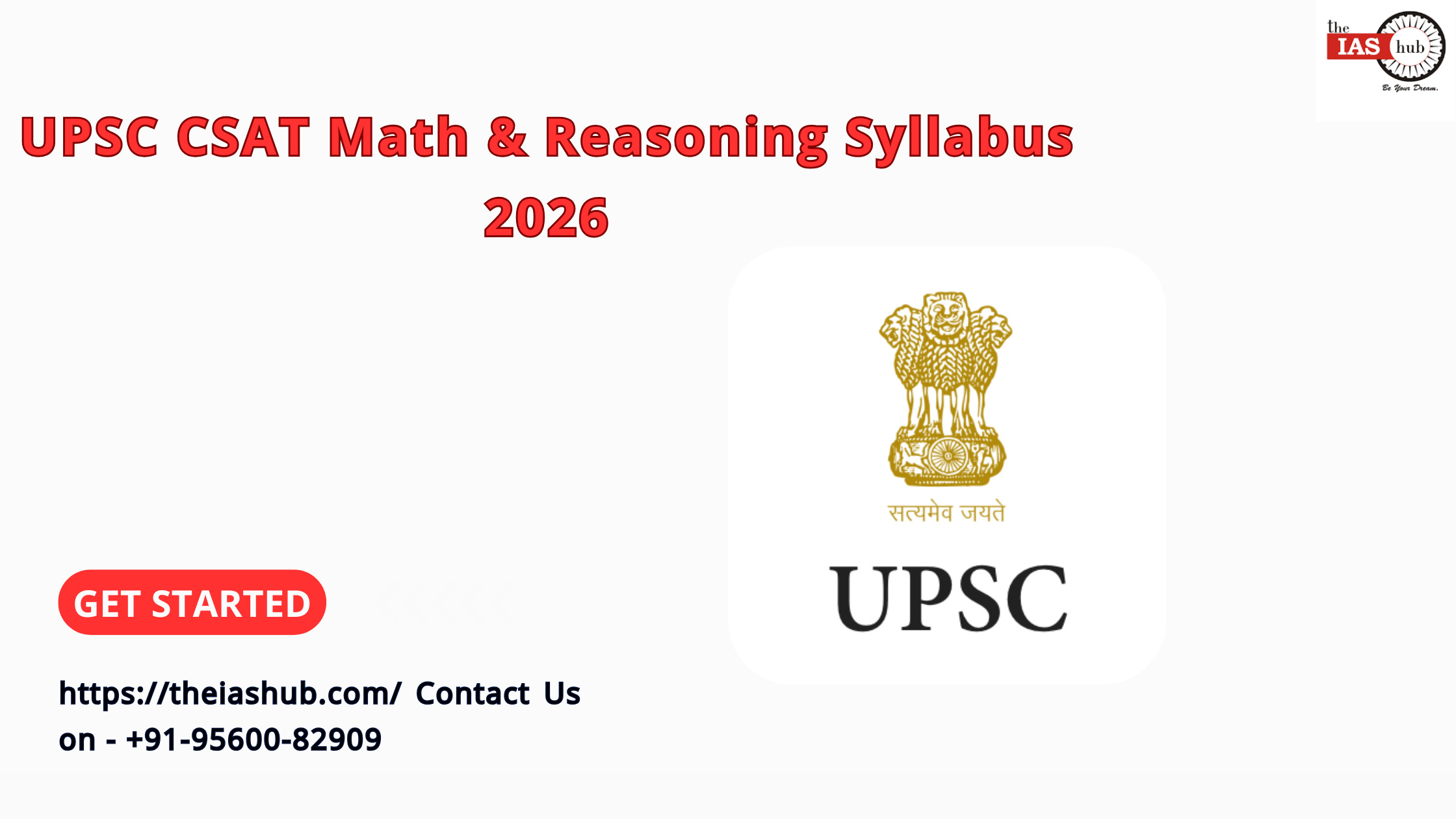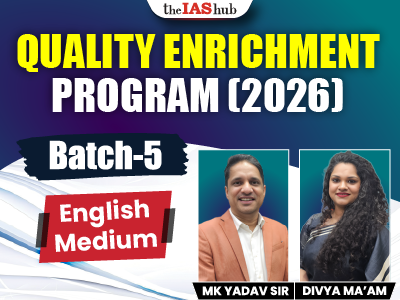Get the complete UPSC CSAT 2026 Math & Reasoning Syllabus with topic-wise details and preparation tips. Master key concepts to qualify for UPSC Prelims GS Paper-2 with ease!


UPSC CSAT Math & Reasoning Syllabus plays a crucial role in the Civil Services Aptitude Test (CSAT), which is an integral part of the UPSC Prelims Exam. Also known as General Studies Paper-II, this paper assesses a candidate’s analytical ability, logical reasoning, data interpretation, and fundamental mathematical skills. Since the CSAT is a qualifying paper, securing the required 33% marks (66 out of 200) is mandatory to qualify for the UPSC Mains Examination.
The CSAT paper assesses a candidate’s problem-solving abilities and logical thinking skills. Although it is only qualifying, failing to secure 33% marks can prevent candidates from progressing to the Mains stage. Therefore, developing a structured study plan must focus on all important topics.
The CSAT syllabus is broadly divided into two major sections:
The Math section of CSAT focuses on basic numerical ability and mental calculations. Candidates must develop a strong foundation in mathematical concepts and practice regularly to improve their speed and accuracy. Below is a detailed breakdown of the UPSC CSAT Math Syllabus 2026:
| Topic | Description |
| Number System | Prime numbers, composite numbers, divisibility rules |
| LCM & HCF | Least Common Multiple and Highest Common Factor |
| Rational Numbers & Ordering | Comparing and arranging numbers |
| Square Roots & Cube Roots | Finding roots of perfect and imperfect squares and cubes |
| Averages | Mean, median, and mode calculations |
| Set Theory | Basics of sets and Venn diagrams |
| Decimal Fractions | Operations on decimals and fractions |
| Ratio & Proportion | Direct and inverse variations |
| Simplification | Solving complex calculations using shortcuts |
| Surds & Indices | Laws of indices and their applications |
| Divisibility Rules | Checking divisibility using simple tricks |
| Percentages | Finding percentage increase/decrease and related calculations |
| Remainder Theorem | Applications in divisibility tests |
| Probability | Basics of probability and real-life applications |
| Trains | Problems related to relative speed and crossing time |
| Boats & Streams | Upstream and downstream problems |
| Time & Work | Work done by individuals and groups |
| Partnership | Profit-sharing ratio in business investments |
| Simple & Compound Interest | Interest calculations over time |
| Mensuration & Area | Perimeter, area, and volume calculations |
| Time & Distance | Speed, distance, and time calculations |
| Profit & Loss | Discounts, marked price, and cost price calculations |
| Work & Wages | Wage distribution based on work done |
| Pipes & Cisterns | Filling and emptying problems |
| Permutation & Combination | Arrangements and selections |
| Alligation & Mixtures | Mixing ratios of two substances |
| Geometry | Basic shapes, theorems, and constructions |
Also Read: UPSC CSAT Syllabus 2026
The Reasoning section of CSAT is divided into two broad categories: Logical Reasoning & Analytical Ability (LR & AA) and Data Interpretation & Data Sufficiency (DI & DS).
| Topic | Description |
| Mathematical Puzzles & Patterns | Recognising numerical patterns |
| Bar Charts | Analysing bar graph-based data |
| Statements & Conclusions | Drawing conclusions from given facts |
| Cubes & Dice | Counting and orientation-based problems |
| Deriving Conclusions | Logical deductions from given statements |
| Syllogism | Relationship between statements and conclusions |
| Inserting the Missing Character | Identifying missing numbers/letters |
| Eligibility Tests | Evaluating conditions for selection |
| Analytical Reasoning | Deductive and inductive logic problems |
| Statement & Assumptions | Identifying implicit assumptions |
| Cause & Effect | Relationship between events and their impact |
| Calendars & Clocks | Time-based reasoning questions |
| Statements & Arguments | Evaluating argument strength |
| Table Charts | Data-based analysis |
| Situation Reaction Tests | Selecting the best response to a situation |
| Pie Charts | Understanding circular data representation |
| Number Ranking & Time Sequence Tests | Ordering elements in a sequence |
| Arithmetical Reasoning | Application of arithmetic in reasoning |
| Punch Lines | Understanding meaning and implications |
| Topic | Description |
| Alphabet Test | Ordering and positioning of the alphabet |
| Coding-Decoding | Deciphering coded messages |
| Blood Relations | Solving family relation puzzles |
| Seating Arrangement | Linear and circular seating problems |
| Logical Venn Diagram | Representation of logical relationships |
| Direction Sense Test | Analysing movement-based questions |
| Mathematical Operations | Applying operations to symbols and numbers |
| Series | Identifying number/letter sequences |
| Classification | Identifying the odd one out |
| Analogy | Finding relationships between different elements |
Quantitative Aptitude/Basic Numeracy
Important topics for basic numeracy are given below:
Logical and Analytical Reasoning
Logical reasoning is an important section. Candidates should focus on the following areas:
While the CSAT paper is qualifying, candidates should not take it lightly. A structured approach can help in achieving the required 33% marks easily.
Are you preparing for UPSC 2026? Join IAShub’s UPSC coaching batches to boost your preparation. Enrol now!
No, basic numeracy and mathematical reasoning are compulsory. However, the level is easy, and with practice, any candidate can perform well.
CSAT is a 200-mark paper, so 33% means a candidate needs to score 66 marks to qualify.
Yes, with regular practice and proper strategy, clearing CSAT is manageable. Since it is only qualifying in nature, candidates should focus on accuracy and time management to ensure they meet the required score.


Refine your answer writing skills and elevate your UPSC preparation with personalized support and expert feedback.
Fill out the form to get started with the program or any other enquiries !








Are you dreaming of becoming an IAS officer? Then, IAShub can be your best guide. It is one of the Best IAS Coaching in Delhi. Many students who want to clear the UPSC exam join IAShub for learning. The institute gives both online and offline classes. Their teachers are experienced and helpful. They easily explain every topic. Students also get notes, tests, and tips to do well in the exam.
IAShub is in Delhi and is trusted by many UPSC students. It offers coaching for every part of the UPSC exam – Prelims, Mains, and Interview. The classes are simple and easy to understand. The teachers are experts and guide students in the right way. IAShub is also known for its helpful notes, test series, and answer-writing practice. IAShub is the best coaching in Delhi and also gives UPSC Online Classes. This helps students from any place in India to learn. The online classes are live and also recorded. So, students can watch them anytime. These classes cover the full UPSC syllabus.
Here are some important services provided by IAShub:
The UPSC Civil Services Exam has three parts:
This exam is tough, but with the right guidance, it becomes easy to manage. Students must study smart and stay regular.
IAShub supports students from the beginning to the end. It gives the right books, tests, and notes. The classes are easy to follow, and the teachers are always ready to help. Students get personal doubt sessions too. The test series and answer checking help students learn where they need to do better. Also, free study materials save time and money.
IAShub also guides students during the final stage – the interview. Experts take mock interviews and give useful tips. This full support makes IAShub one of the best IAS coaching in Delhi.
